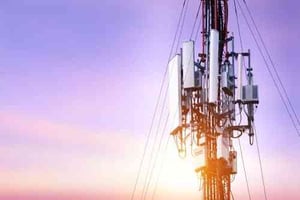Small Cell Technology: Top Joint Use Challenges

Endless demand for wireless data and advances in technology are ushering in the Internet of Things (IoT) and artificial intelligence (AI). These developments depend on the infrastructure and support of the next generation of wireless connectivity, 5G.
Small Cell Technology Paves the Way for 5G Wireless
The 4G/LTE network of macro cell wireless towers cannot provide sufficient coverage or bandwidth to meet the needs of top-speed 5G. The communications industry is deploying tens of thousands of small cell antennas to supplement the existing wireless infrastructure and support the growing 5G networks. By blanketing an area with small cell attachments on utility poles, street lights, and other joint use assets, carriers are forming dense networks that can improve network capacity up to 1,600 times, and improve network performance by 315 percent.
The annual number of small cell attachments in the United States increased from about 13,000 in 2017 to 46,000 in 2019, bringing the total number of active sites in the country to almost 400,000. It’s unclear how many sites have been added so far in 2020, but it’s safe to say thousands, even with the challenges presented by the pandemic.
Small cell deployment requests continue to rapidly hit utility companies and other joint use asset owners nationwide. For more information on 5G, read Small Cell Attachments Pave the Way for 5G Wireless.
What Are Small Cell Attachments?
Small cell antennas operate on the same radio access technology as WiFi, Bluetooth, and 3G/4G (LTE). Much smaller in size than standard macrocell towers, they require minimal power to operate, have a shorter range, and handle fewer concurrent calls or sessions. Their size makes it easier to install on light poles and atop buildings.
There are three types of small cells, which are typically defined by their range of coverage: Femtocells, Picocells, and Microcells. While most traditional attachments are limited to cables, small cell requires several pieces of equipment: an antenna, a power source, energy meter housing, a disconnect unit, backhaul equipment (dark fiber, lit circuits, cable TV, or wireless), and a weather-head from the meter shell up the pole into the power zone.
For more information on the basics of small cell, read the first article in our small cell series: Small Cell Attachments: An Introduction for Joint Use Owners.
How Is Small Cell Different from DAS?
DAS has been in use longer than small cell, and is often considered the “original” small cell. While DAS and small cell share similar outputs, coverage areas, and size, they are different solutions for different needs. They are often viewed as complementary technologies.
DAS can support multiple frequencies (2G, 3G, 4G/LTE, 5G, VHF bands), can be shared by multiple carriers, and use one central power supply for multiple nodes. Small cell typically supports a single, defined frequency.
Small cell supports a few dozen simultaneous subscribers, and is designed to deliver coverage and capacity over a relatively small area (similar to a Wi-Fi access point), while a single DAS base transceiver station can serve up to approximately 1,800 users and provide a coverage radius of several miles by adjusting the power to the antennas.
Read about other ways DAS and small cell differ here: DAS vs. Small Cell: 7 Ways They Are Different.
Small Cell Installation
Small cell architecture requires all related equipment to be positioned on the pole, interconnected, and grounded according to the pole owner’s requirements (and NESC or state guidelines).
Small cell installations are ideally placed at the top of the pole—above the power space—to minimize radio interference. Small cell deployment on existing joint use infrastructure can create challenges, including overlashing, safety, pole loading, and engineering design. Good design and engineering are crucial to successful small cell deployment.
Without a common set of industry standards and procedures for small cell installation, the joint use industry is doing its best to manage the sudden rush. Read more information about how joint use owners and attachers are adapting to change in our article, Managing the Explosion of Small Cell.
No Standard Guidelines for Small Cell Deployments
While there are not industry-accepted guidelines for small cell installation, at least 28 states have enacted small cell legislation.
Although the FCC doesn’t regulate pole attachments in every single state, it is likely that municipal utilities, cooperatives, state-managed utilities, and others will follow the FCC’s lead of regulations. In multiple orders issued in 2018, the FCC attempted to speed up Americans’ access to 5G coverage by cutting small cell deployment costs and timelines.
The Joint Use Industry’s Response to Small Cell Deployments
In their efforts to meet the FCC’s regulations for small cell deployments, asset owners can ease small cell attach permitting tasks by streamlining their joint use processes.
Using an asset data management system can simplify joint use processes in order to consolidate data in an easily accessible format, enable secure asset data sharing, integrate joint use data with other internal systems like GIS and accounting, and develop efficient workflows that automate tasks.
What Small Cell Attachers Need to Know About Your Joint Use Assets
With DAS and small cell, there’s a lot more equipment involved and, therefore, also a lot more engineering involved on the pole owner’s side. Most of the data that attaching companies need to determine whether a pole (or streetlight or traffic light) is a good fit for their small cell attachment is basic asset data, including:
- Who owns the asset
- Asset type
- Asset height
- Location
- Material
- Number of existing attachments
- Power availability
A significant step in making small cell deployments easier and less resource-intensive is to simplify joint use asset management by utilizing a centralized platform.
Backhaul and Small Cell
The backhaul shares a very important role in the deployment of small cell.
High performance of fiber is crucial to successfully deploying small cell and keeping consumers happy. Optical fiber is the most favored method of backhaul for small cell deployment because of its range, capacity, and bandwidth. In some places, fiber may be impractical, expensive, or too time-consuming.
For more information about backhaul considerations and challenges, read Small Cell Backhaul Requirements for Telecommunications.
The Future of Small Cell
The advances in internet technology are setting consumers and companies up for the future. As predicted, the Internet of Things (IoT) and artificial intelligence (AI) has grown increasingly popular and will continue to do so.
Small cell is the key to tapping into the full potential of smart cities, in which sensors will perform a multitude of functions that increase efficiency, save money, and improve public safety.
Smart lighting (in smart cities) will automatically dim public lights on empty streets and turn them back on if a person or vehicle appears. Traffic lights will respond to actual traffic, reducing congestion. Drivers and passengers will be able to use apps to access real-time information on parking spaces.
Read about other key insights in: 6 Ways Small Cell is Impacting the Industry.
The Road Ahead
All factors indicate that the growing deployment of small cell attachments will continue to intensify, presenting challenges for asset owners and attachers/renters. Logical procedures and strong coordination between all parties involved are the keys to managing deployment as smoothly as possible.
Over the coming years, small cell technology will continue to proliferate, creating a dense 5G network that is capable of supporting the IoT, self-driving cars, and thousands of streaming devices in a single concert stadium. Small cell is the next big transition for the joint use industry.
Download our guide today to learn how to meet the challenges associated with small cell technology. For questions about our products or services, book a meeting here.
